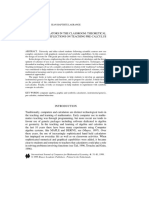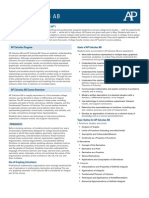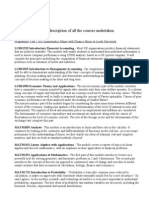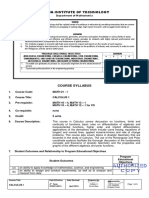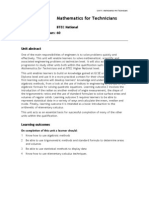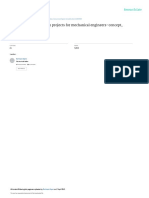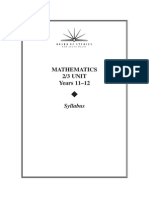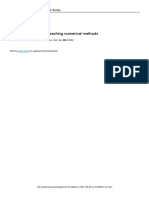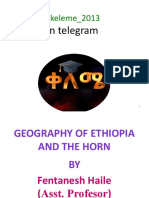Btec Int l3 Engineering Delivery Guide Unit 7
Btec Int l3 Engineering Delivery Guide Unit 7
Uploaded by
isaacnosayaba2006Copyright:
Available Formats
Btec Int l3 Engineering Delivery Guide Unit 7
Btec Int l3 Engineering Delivery Guide Unit 7
Uploaded by
isaacnosayaba2006Original Title
Copyright
Available Formats
Share this document
Did you find this document useful?
Is this content inappropriate?
Copyright:
Available Formats
Btec Int l3 Engineering Delivery Guide Unit 7
Btec Int l3 Engineering Delivery Guide Unit 7
Uploaded by
isaacnosayaba2006Copyright:
Available Formats
UNIT 7: CALCULUS TO SOLVE ENGINEERING PROBLEMS
Unit 7: Calculus to Solve Engineering
Problems
Delivery guidance
This unit builds on mathematical techniques covered in the mandatory unit Engineering
Principles, and hence it is suggested that it is delivered after or at the same time as Unit 1:
Mechanical Principles and/or Unit 57: Electrical and Electronic Principles. Learners will
investigate the rules and manipulation techniques of calculus and apply them to the
solution of engineering problems, making them aware of the importance of understanding
advanced mathematical techniques. You should encourage learners to develop their pure
mathematical skills by using them in an applied environment.
You should enable learners to appreciate why correctly modelling of an engineering system
using differential and/or integral calculus techniques is important: working with numbers is
much more cost effective than building hardware that does not perform to specification.
Your learners’ algebraic manipulation, numerical accuracy and presentation skills will develop
so that assignments can be presented to an agreed standard.
A large part of this unit involves the teaching and learning of mathematical techniques that
are transferable and not just specific to engineering. For the first two learning aims, the unit
content is structured so that your learners will initially investigate generic calculus
techniques and then develop them to produce the solutions to engineering problems. The
third learning aim focuses on the solution of a complex, defined, specialist engineering
problem by applying thinking skills (eg reductionism) and modelling techniques (analytical
and numerical).
To complete this unit, your learners will need access to a spreadsheet package. You can
use a range of delivery methods in this unit, such as:
● formal teaching
● individual and small-group investigation
● structured worksheets
● case studies.
Learners will benefit from access to web-based mathematics support.
This unit, like the other mandatory units, could be delivered in a specialist context such as aeronautical,
manufacturing or electrical and electronic engineering. For example, a centre wanting to deliver the
mandatory units in an electrical/electronic context could explore a range of problems linked to electrical
applications. However, care must be taken to ensure learners are prepared before they attempt the internal
assessment activities.
You can involve local employers in the delivery of this unit if there are local opportunities to do so.
Pearson BTEC International Level 3 Qualifications in Engineering – Delivery Guide Issue
1
1 – October 2019 © Pearson Education Limited 2019
UNIT 7: CALCULUS TO SOLVE ENGINEERING PROBLEMS
Approaching the unit
You should make your learners aware that there are two strands to the teaching and
assessment of this unit. The first strand is to teach learners how to apply the principle of
calculus to a range of polynomial, trigonometric, logarithmic and exponential functions. To
do this will require formal classroom delivery supported by significant amounts of learner
practice in the form of graded worksheets. You should work with the universally accepted
variables ‘x’ and ‘y’ but, as the unit develops, replace them with those used by engineers, for
example ‘s’ (displacement) and ‘t’ (time). This first strand is, in effect, pure mathematics with
an engineering ‘flavour’.
The second strand is the use of calculus to solve real engineering problems and much of
your teaching will be in form of supporting learners as they carry out self-directed study
done on an individual or small-group basis. You should guide learners to use calculus
techniques when studying other units within their programme, for example, to determine
the maximum bending moment in a beam or the energy discharge from an electronic
capacitor. Throughout your teaching of this unit, do reinforce the notion that mathematics
is a modelling process that is much more interesting and valuable than simply a set of
routines to be learnt by rote. Guide your learners to correctly present what they set out on
paper, be it hand-written or computer-generated; mathematics is a communicative
language.
Delivering the learning aims
For learning aim A, introduce the topic by showing your learners a displacement– time graph
for an object that is accelerating in a straight line with constant acceleration. Discuss how you
might determine the object’s instantaneous velocity and acceleration at a given time point
on the graph. Remind them of the concept of gradient, which they will have already
investigated when they studied Unit 1: Mechanical Principles. Through discussion, develop
the concept of rate of change and think about other engineering situations where there are
time dependent processes happening, for example heat transfer, flow of electrical charge,
mechanical energy and power.
Explain to your learners that, in the initial stages of delivering this learning aim, they will learn about
differential calculus manipulation techniques, the starting point being different types of mathematical
function (building on what they learnt in Unit 1: Mechanical Principles). Follow this up with a graphical
explanation of gradient, small change and limiting value (derivative) of a simple power function such
as y = x2. Once your learners understand the concepts of variables and rates of change, you can go on
to work through the various rules of differential calculus as set out in the unit content. This will have to
be done in a formal way – with initial classroom delivery followed by worksheets. Until learners are
confident in applying the various rules of differentiation, for example the product and quotient rules,
your learners will not be able to move on.
To make the learning aim more accessible, it is important to incorporate spreadsheet
mathematics, particularly when investigating the turning points and second derivative. You
will need to explain to learners how to find the maximum and minimum points of a function
(eg finding the maximum and minimum bending moments for a beam) by using differential
calculus (analytical method) and plotting (graphical, spreadsheet method) and then use the
second derivative to confirm that the point is a maximum or minimum.
Learners can find the concept of variables tending to zero (limiting value/Leibniz notation)
very difficult to accept; for a lot of the content in learning aim A (and also B) they can just
mechanically apply the rules of differentiation and work with the table of standard
differential coefficients. They need to be convinced of what (dy/dx or ds/dt) means – this is
easily done by setting out functions in spreadsheets, plotting, and following up with ‘what if’
repetitive calculation. You should use animations sourced from on-line mathematics support
packages to reinforce your teaching of
Pearson BTEC International Level 3 Qualifications in Engineering – Delivery Guide Issue
2
1 – October 2019 © Pearson Education Limited 2019
UNIT 7: CALCULUS TO SOLVE ENGINEERING PROBLEMS
learning aim A.
Assessment of this learning aim will be through the use of a time-constrained, controlled
assignment; your learners should be given a formulae sheet and the table of derivatives.
Assignment tasks are based on the application of differential calculus techniques and not
just simple recall of techniques (i.e. they are not memory tests).
For learning aim B, introduce the topic by telling your learners that, in simplistic terms,
integration is the ‘reverse’ of differentiation. Get them to have a look at the table of standard
integrals and compare with the table of derivatives. Before moving on to teach the rules of
integral calculus, do introduce the concept of area measurement and summation. Start by
discussing how to measure the areas of regular shapes such as rectangles and triangles.
Then pose the question: ‘How do we measure the area of an irregular shape?’. Lead the
discussion to consider splitting the shape up into a number of smaller, regular pieces or, if
the outline of the shape can be defined by a mathematical function, using a summating
technique based on integral calculus and/or a numerical method such as the trapezium rule.
Then explain to your learners that, as with the first learning aim, before they can apply
calculus techniques, they must first learn the rules. This will have to be done in a formal way,
that is, by initial classroom delivery followed by individual activities using worksheets.
The types of function to be investigated will be the same as those in learning aim A; do
ensure that your learners are fully competent in applying the rule of integration eg
integration by parts. Having mastered the rules of integration, your learners can move on to
investigate how integration is used as a summating tool; the concept of strip theory can be
difficult to grasp and you may find it useful to support your delivery with animations sourced
from on-line mathematics support packages. Understanding the significance of ‘tending to
zero’ can be difficult for some learners.
As with learning aim A, in learning aim B learners can just mechanically apply the rules of
integration. What you should be doing is encouraging them to investigate engineering uses
for integral calculus, in particular, as a summation tool for finding the defined areas of
plotted functions. To ‘convince’ your learners that summation using analytical calculus is
valid, you will need to show them how to carry out numerical integration using spreadsheet
mathematics. Summation techniques link very well to content within other units in their
programme, for example mechanical/electrical energy transfer.
Assessment of this learning aim will be through the use of a time-constrained, controlled
assignment for which your learners should be given a formulae sheet and the table of
integrals. Assignment tasks are based on the application of integral calculus techniques and
not just simple recall of techniques (i.e. they are not memory tests).
For learning aim C, you will be developing the application of thinking methods to the
solution of a complex problems, that is, breaking a problem down into a set of linked
manageable steps, each of which is solvable through the use of calculus (differential and
integral). Your learners will have been doing this already when they were working with non-
routine functions (learning aims A and B) and in other programme units. For this learning
aim, you will probably only have to provide a small amount of formal input. Most of your
support for learners will take the form of providing guidance as they investigate a complex
engineering problem and mathematically model it.
Pearson BTEC International Level 3 Qualifications in Engineering – Delivery Guide Issue
3
1 – October 2019 © Pearson Education Limited 2019
UNIT 7: CALCULUS TO SOLVE ENGINEERING PROBLEMS
Start by reviewing the use of reductionism, synectics (idea connection) and logical thinking;
this does not have to be directly related to mathematics as the principles are generic. A
group discussion led by you is a good way to cover this topic. In preparation for assessment
of this learning aim, you should provide your learners with one or two well defined case
studies and ask them to come up with solutions to be presented to the group and evaluated.
Assessment of this learning aim will be through the use of a time-constrained, controlled
assignment for which your learners should be given a formulae sheet, the table of integrals
and a pre-release case study to set the scene.
Learning aim Key content areas Recommended
assessment approach
A Examine how differential A1 Functions, rate of
calculus can be used to change, gradient
solve engineering A report containing the
A2 Methods of
problems results of learners’ analysis
differentiation
and calculation, carried out
A3 Numerical value of a under controlled conditions.
derivative
A4 Second derivative and
turning points
B Examine how integral B1 Integration as the
calculus can be used to reverse/inverse of A report containing the
solve engineering differentiation results of learners’ analysis
problems and calculation, carried out
B2 Integration as a summating
under controlled conditions.
tool
B3 Numerical integration
C Investigate the application C1 Thinking methods
of calculus to solve a A report containing the
C2 Mathematical modelling
defined specialist results of learners’ analysis,
of engineering problems
engineering problem planning and calculation,
C3 Problem definition and carried out under controlled
proposed solution conditions.
C4 Solution implementation
Assessment guidance
This unit is internally assessed and you should use three time-constrained assignments.
There are authorised assignments for this unit, each covering one learning aim. If you
choose to use your own assignment briefs, it is essential that each one covers a complete
learning aim and is not split into sub-tasks for each criterion.
Each learner must independently generate their own evidence presented as a portfolio.
There is no requirement for them to word process their mathematical manipulations; for
most learners, hand-written will be the most time efficient method of presentation.
Repetitive numerical evidence (eg spreadsheets and graphs) is better when presented in
printed form. It is important that learner evidence is fully authenticated. For learning aims
A and B, evidence should be based on fixed tasks; for learning aim C, learners may wish to
discuss with you their solution strategy for an identified engineering problem and this
could involve the use of an observation record to support their evidence.
Pearson BTEC International Level 3 Qualifications in Engineering – Delivery Guide Issue
4
1 – October 2019 © Pearson Education Limited 2019
UNIT 7: CALCULUS TO SOLVE ENGINEERING PROBLEMS
Getting started
This gives you a starting place for one way of delivering the unit, based around the
recommended assessment approach in the specification.
Unit 7: Calculus to Solve Engineering problems
Introduction
Begin by introducing the unit to your learners through a group discussion exploring the reasons
why mathematics is such an important tool in supporting all aspects of engineering. Move your
learners away from the simplistic reasons for learning mathematical skills and talk to them about
the wider and much more exciting aspects of mathematical modelling. Tell them that
mathematical modelling is something we all do every day, for example money budgeting, and
then open out the discussion to think about why it is crucial to design engineering products so
that they perform to specification.
Explain to your learners that calculus is a subset of mathematics that is of particular use to
engineers because it allows them to investigate time-based systems, for example aircraft
performance. As an example, you could talk in general terms about the design and development
of a typical new commercial aircraft – everything is worked out using mathematical modelling so
that, when the first one rolls off the production line, the pilot knows it will handle exactly as
predicated in the simulator. Mathematics, as an engineering tool, has the same significance as
the most complex CNC machining centre.
It is important to motivate learners particularly in the early stages of this unit which can seem dry
some of the time.
Learning aim A – Examine how differential calculus can be used to solve
engineering problems
● Using a formal presentation you could review types of function, making reference to Unit 1:
Mechanical Principles and Unit 57: Electrical and Electronic Principles.
● You could run a short quiz about types of function to identify learners who may require
additional support.
● You could demonstrate access to the ‘mathcentre’ website (see Resources) and ask learners
to pick a level 2/3 topic. For some topics there are four options to choose from: ‘teach
yourself’, ‘video’, ‘practice and revision’ and ‘test yourself’. As a fun group exercise, do a
couple of the algebra tests.
● You should now carry out formal teaching of unit content A1 and A2, supporting your
teaching with self-directed learner activities, such as worksheets.
● When your learners have mastered the basic concepts of differential calculus, you can move
on the more interesting applications of differentiation in engineering (content A3 and A4).
This will require formal instruction from yourself but there should also be an emphasis on
learner-centred activities.
● In preparation for the assessment activity, you could guide your learners through:
o plotting the graphs of given functions either by hand or by using a spreadsheet and
measuring their gradients at different points
o using the first derivative for each of the functions to calculate the gradient at different
points and comparing these with the graphically found values
Pearson BTEC International Level 3 Qualifications in Engineering – Delivery Guide Issue
5
1 – October 2019 © Pearson Education Limited 2019
UNIT 7: CALCULUS TO SOLVE ENGINEERING PROBLEMS
o finding the first and second derivatives for given functions
o finding the turning points of polynomial and trigonometric functions
o investigating the use of maximum and minimum theory to solve engineering
problems, for example optimising the dimensions of a container so that its internal
volume is at a maximum but its surface area is a minimum.
● Once your learners have established the most effective dimensions for the container, it is
worth repeating the exercise using numerical analysis. Using a spreadsheet, set up
formulae for the volume and surface area, step through a range of dimensions, plot out
the figures and find where the maximum occurs – does it agree with the value found by
maximum/minimum theory?
Learning aim B – Examine how integral calculus can be used to solve
engineering problems
● Using a formal presentation, you could review types of function, making reference to Unit 1:
Mechanical Principles, Unit 57: Electrical and Electronic Principles and learning aim A.
● You could talk through the table of standard integrals and compare its layout with the
table of differentials.
● You could give your learners a brief worksheet of polynomial functions, ask them to
differentiate and then do the reverse action of integration; then talk about the constant of
integration.
● Your learners could be reminded about the mathcentre website and the link to integral
calculus support.
● When your learners have mastered the basic concepts of integral calculus, you can move on
the more interesting applications of it to engineering (content B2 and B3). This will require
formal instruction from yourself but there should also be an emphasis on learner-centred
activities.
● In preparation for the assessment activity you could guide your learners through:
o finding indefinite and definite integrals for a range of given functions
o investigating the use of numerical and analytical integration methods to solve
engineering problems
o finding the properties of periodic functions using integral calculus
o finding the areas of shapes with outlines defined by mathematical functions and
applying this to engineering situations (eg determination of work done/energy transfer).
Pearson BTEC International Level 3 Qualifications in Engineering – Delivery Guide Issue
6
1 – October 2019 © Pearson Education Limited 2019
UNIT 7: CALCULUS TO SOLVE ENGINEERING PROBLEMS
Learning aim C – Investigate the application of calculus to solve a defined
specialist engineering problem
● This learning aim builds on the knowledge and understanding from learning aims A and B.
You could use formal teaching to introduce thinking methods but most of the topic content
is best covered as self-directed investigation.
● In preparation for the assessment activity, you could guide your learners through:
o using thinking methods to analyse an identified engineering problem (eg
breaking the problem down into a series of manageable elements, and
producing a specification)
o preparing a valid proposal for solving the problem and presenting the proposal to an
audience
o producing mathematical models for the identified elements of the problem
solving the problem using both differential and integral calculus methods to produce
answers for each of the elements of the problem and critically analyse the results
o presenting the solution as a formal presentation.
● The problem to be solved could be taken from another unit within the BTEC
programme to suit the learner’s specialist area of study, for example:
o the stress analysis of a load carrying structure where differentiation is applied to
determine maximum and minimum bending moments and integration is used to
determine the ‘I’ value for a beam (i.e. the moment of inertia) with a non- regular cross
section.
o analysis of the signal frequency from op-amp differentiator and integrator circuits.
o Learners should be encouraged to incorporate spreadsheet maths into the presentation.
Pearson BTEC International Level 3 Qualifications in Engineering – Delivery Guide Issue
7
1 – October 2019 © Pearson Education Limited 2019
UNIT 7: CALCULUS TO SOLVE ENGINEERING PROBLEMS
Details of links to other BTEC units and qualifications, and to
other relevant units/qualifications
Pearson BTEC International Level 3 Qualifications in Engineering:
● Unit 1: Mechanical Principles
● Unit 15: Electrical Machines
● Unit 17: Power and Energy Electronics
● Unit 20: Analogue Electronic Circuits
● Unit 27: Static Mechanical Principles in Practice
● Unit 28: Dynamic Mechanical Principles in Practice
● Unit 29: Principles and Applications of Fluid Mechanics
● Unit 31: Thermodynamic Principles and Practice
● Unit 48: Aircraft Flight Principles and Practice
● Unit 57: Electrical and Electronic Principles
Resources
There are no special resources required for this unit but your learners will benefit from access
to maths support websites.
In addition to the resources listed below, publishers are likely to produce Pearson-
endorsed textbooks that support this unit of the BTEC International Level 3
Qualifications in Engineering. Check the Pearson website
(http://qualifications.pearson.com/en/support/published-resources.html) for more
information as titles achieve endorsement.
Textbooks
● Boyce A, Cooke E, Jones R, Mantovani B, Roberts D and Weatherill B – BTEC Level 3
National Engineering Student Book (Pearson, 2010)
ISBN 9781846907241.
This contains learner support activities.
● Bird J – Engineering Mathematics (Elsevier Science & Technology, 2007) ISBN
9780750685559.
Useful exercises to complement teaching.
● Fuller A, Greer A and Taylor G W – BTEC National Mathematics for Technicians, 3rd
Edition (Nelson Thornes, 2004) ISBN 9780748779499. Useful additional resource.
● Tooley M and Dingle L– BTEC National Engineering, 2nd Edition (Elsevier Science &
Technology, 2007) ISBN 9780750685214.
A good course textbook.
● Greer A and Taylor G W – BTEC National NIII Mathematics for Technicians
(Nelson Thornes, 1991) ISBN 9780859509329.
Maths activities.
● Greer A and Taylor G W – BTEC National Further Mathematics for
Technicians (Nelson Thornes, 2005) ISBN 9780748794102. Higher-level
maths activities.
Pearson BTEC International Level 3 Qualifications in Engineering – Delivery Guide Issue
8
1 – October 2019 © Pearson Education Limited 2019
UNIT 7: CALCULUS TO SOLVE ENGINEERING PROBLEMS
Websites
● www.mathcentre.ac.uk/students/topics
The mathcentre is a free and robust resource. It provides easy access to
topic reviews, revision worksheets, tests and animations.
● www.ncetm.org.uk
The National Centre for Excellence in the Teaching of Mathematics website –
this site provides ideas and support for teachers to enhance mathematics
teaching.
Pearson is not responsible for the content of any external internet sites. It is essential for tutors to preview each
website before using it in class so as to ensure that the URL is still accurate, relevant and appropriate. We suggest
that tutors bookmark useful websites and consider enabling learners to access them through the school/college
intranet.
Pearson BTEC International Level 3 Qualifications in Engineering – Delivery Guide Issue
9
1 – October 2019 © Pearson Education Limited 2019
You might also like
- Holt Practice Workbook Grade 6Document73 pagesHolt Practice Workbook Grade 6api-3737777230% (2)
- Edtpa Planning CommentaryDocument7 pagesEdtpa Planning Commentaryapi-214069084100% (2)
- Calculus: An Intuitive and Physical Approach (Second Edition)From EverandCalculus: An Intuitive and Physical Approach (Second Edition)Rating: 4.5 out of 5 stars4.5/5 (8)
- Syllabus IBMDocument28 pagesSyllabus IBMManas KhareNo ratings yet
- Statistics in Civil EngineeringDocument8 pagesStatistics in Civil EngineeringdebasisdgNo ratings yet
- Grade 12 CalculusDocument19 pagesGrade 12 CalculusJoyRaeJeposaNo ratings yet
- Worksheet: Pythagorean Theorem Problems: Multiple ChoiceDocument6 pagesWorksheet: Pythagorean Theorem Problems: Multiple Choiceapi-288922072No ratings yet
- JGU Statistics BusinessMath Course OutlineDocument8 pagesJGU Statistics BusinessMath Course OutlineProNo ratings yet
- AP Calculus BC SyllabusDocument12 pagesAP Calculus BC SyllabusNasir IqbalNo ratings yet
- Mathematics: CRAFTY Curriculum Foundations Project Mathematical Sciences Research Institute, February 9-11, 2001Document5 pagesMathematics: CRAFTY Curriculum Foundations Project Mathematical Sciences Research Institute, February 9-11, 2001Tava EurdancezaNo ratings yet
- Ebook Download Applied Calculus 5th Edition (Ebook PDF) All ChapterDocument43 pagesEbook Download Applied Calculus 5th Edition (Ebook PDF) All Chaptermabrameau15100% (8)
- Mat Mod Report 6Document15 pagesMat Mod Report 6Renny BalaNo ratings yet
- Ap Calculus Ab Syllabus StumlerDocument12 pagesAp Calculus Ab Syllabus Stumlerapi-254378905No ratings yet
- Traditional Mathematics (Sometimes Classical Math Education) Was TheDocument11 pagesTraditional Mathematics (Sometimes Classical Math Education) Was TheMapandi Tee EmNo ratings yet
- AO2 Analysis Exercises and ActivitiesDocument9 pagesAO2 Analysis Exercises and ActivitiesBhavishka ValraniNo ratings yet
- SOW CE62021-2-MALG 16 WeeksDocument10 pagesSOW CE62021-2-MALG 16 WeeksMichael HillNo ratings yet
- Math Application For MeDocument10 pagesMath Application For MeDetec Tive Roy TizonNo ratings yet
- Discrete Math CoursesDocument8 pagesDiscrete Math Coursesbmenot2No ratings yet
- Fluids 04 00178Document18 pagesFluids 04 00178saleamlak muluNo ratings yet
- Calculus 1 SyllabusDocument7 pagesCalculus 1 SyllabusAbdiakim AbdikadirNo ratings yet
- Learning Outcomes 1Document5 pagesLearning Outcomes 1hydlee27No ratings yet
- Lagrange 1999Document32 pagesLagrange 1999Michael Angelo S. PaternoNo ratings yet
- AP Calculus Ab Course OverviewDocument2 pagesAP Calculus Ab Course OverviewHorizonAcademyNo ratings yet
- BSC Mathematics Major With Finance Minor at Leeds University - Course DescriptionDocument6 pagesBSC Mathematics Major With Finance Minor at Leeds University - Course DescriptionVytautas KazlauskasNo ratings yet
- Unit 1: Engineering Principles: Delivery GuidanceDocument10 pagesUnit 1: Engineering Principles: Delivery GuidanceDavid BellNo ratings yet
- Math 21-1 SyllabusDocument6 pagesMath 21-1 SyllabusakladffjaNo ratings yet
- Lesson PlanDocument2 pagesLesson Planapi-466380982No ratings yet
- Math099 SyllabusDocument9 pagesMath099 SyllabustinomutendaNo ratings yet
- Teaching Numerical Methods For Non Linear Equations With Geogebra Based ActivitiesDocument13 pagesTeaching Numerical Methods For Non Linear Equations With Geogebra Based ActivitiesMycas MycasNo ratings yet
- Ijee1136 - Manual Mdsolid InglesDocument7 pagesIjee1136 - Manual Mdsolid Inglesnorman12normanNo ratings yet
- Multi-Disciplinary Approach To Teaching Numerical Methods To Engineers Using MatlabDocument15 pagesMulti-Disciplinary Approach To Teaching Numerical Methods To Engineers Using Matlabshamsukarim2009No ratings yet
- Teaching and Learning in STEM With Computation, Modeling, and Simulation Practices: A Guide for Practitioners and ResearchersFrom EverandTeaching and Learning in STEM With Computation, Modeling, and Simulation Practices: A Guide for Practitioners and ResearchersNo ratings yet
- Mathematics, BSC (Hons) (Post 2018) - 2018-2019Document32 pagesMathematics, BSC (Hons) (Post 2018) - 2018-2019Irslan Ali IrslanaliNo ratings yet
- U4 Maths For TechniciansDocument9 pagesU4 Maths For TechniciansIllingworth10000% (1)
- 2014 - Revised - Math 21-1 SyllabusDocument8 pages2014 - Revised - Math 21-1 SyllabusWincy Sta AnaNo ratings yet
- Mathematical Application Projects For Mechanical eDocument11 pagesMathematical Application Projects For Mechanical eJosephNathanMarquezNo ratings yet
- B.sc. MathematicsDocument61 pagesB.sc. MathematicsKavithaNo ratings yet
- Maths23u SylDocument86 pagesMaths23u SylpeterNo ratings yet
- Excel Spreadsheet in Teaching Numerical MethodsDocument8 pagesExcel Spreadsheet in Teaching Numerical MethodsJoshua Allen AjetoNo ratings yet
- Mechanics CourseworkDocument6 pagesMechanics Courseworkrhpvslnfg100% (2)
- 21 Mat 21Document4 pages21 Mat 21Mani KarthikeyanNo ratings yet
- CDM Teaching Discrete Mathematics To Computer Science MajorsDocument11 pagesCDM Teaching Discrete Mathematics To Computer Science MajorsjpaulinoNo ratings yet
- Complex Calculators in The Classroom Theoretical and Practical Teaching in Pre-CalculusDocument25 pagesComplex Calculators in The Classroom Theoretical and Practical Teaching in Pre-CalculusJonel RuleNo ratings yet
- Lesson Plan Stand Form CalcDocument1 pageLesson Plan Stand Form CalcJonathan RobinsonNo ratings yet
- Number TheoryDocument70 pagesNumber TheoryJera Obsina0% (1)
- TRC Electromechanival Technology Series Mechanisms LinkagesDocument285 pagesTRC Electromechanival Technology Series Mechanisms LinkagesPoor Linoo67% (3)
- 05a Cis PDFDocument2 pages05a Cis PDFAnasaziXNo ratings yet
- Engineering Mathematics TI-92Document16 pagesEngineering Mathematics TI-92MorneNo ratings yet
- Incorporating Engineering Applications Into Calculus InstructionDocument11 pagesIncorporating Engineering Applications Into Calculus InstructionRita VazquezNo ratings yet
- General Mathematics q2 DLLDocument59 pagesGeneral Mathematics q2 DLLRivera Kris IanNo ratings yet
- Document 330 3841Document61 pagesDocument 330 3841larry.cano686No ratings yet
- Projects in Department Wide Junior Civil Engineering CoursesDocument22 pagesProjects in Department Wide Junior Civil Engineering CoursesRodney MahlanguNo ratings yet
- The Abstraction First Approach To Data ADocument16 pagesThe Abstraction First Approach To Data Akabirt636No ratings yet
- 09 Juniati DDocument7 pages09 Juniati DLoran DaweNo ratings yet
- Introduction To Conic Sections and The Circle PDFDocument6 pagesIntroduction To Conic Sections and The Circle PDFSTEM 8 PRODUCTIONSNo ratings yet
- Mathematics Cognitive Processes - Grade 10: KnowingDocument3 pagesMathematics Cognitive Processes - Grade 10: KnowingHorizonAcademyNo ratings yet
- College Department Bachelor of Secondary Education: Prepared byDocument17 pagesCollege Department Bachelor of Secondary Education: Prepared byBelle Torres0% (1)
- Unit A1Document5 pagesUnit A1Rida SnobNo ratings yet
- (Danh Tran DRAFT) Digital Unit Plan Template UpdatedDocument5 pages(Danh Tran DRAFT) Digital Unit Plan Template UpdatedDanh TranNo ratings yet
- Maths in The WorkplaceDocument8 pagesMaths in The WorkplaceMarlon Ty ManaloNo ratings yet
- Brockington College Mathematics Faculty Homework BookletDocument31 pagesBrockington College Mathematics Faculty Homework BookletNayem Hossain HemuNo ratings yet
- Mathematics Es1 s1 Teaching MeasurementDocument129 pagesMathematics Es1 s1 Teaching MeasurementiilongamarthinNo ratings yet
- Math10Q2M2 Activity SheetsDocument10 pagesMath10Q2M2 Activity SheetsLavinia RamosNo ratings yet
- General SATDocument7 pagesGeneral SATIddosa AsfawNo ratings yet
- Secondary School Annual Examinations 2004Document10 pagesSecondary School Annual Examinations 2004Taslim DookyNo ratings yet
- Grade 6 Lesson PlansDocument49 pagesGrade 6 Lesson PlansDineo MoilweNo ratings yet
- Budget of Work in MathDocument9 pagesBudget of Work in Mathmary jean sumalinogNo ratings yet
- SPM Trial 2009 Math Q&A (Melaka)Document56 pagesSPM Trial 2009 Math Q&A (Melaka)SimPorNo ratings yet
- ST - Tajinder Kaur - IT-2 (Sem-7) - 082Document37 pagesST - Tajinder Kaur - IT-2 (Sem-7) - 082Tajinder Kaur MarwahNo ratings yet
- Lunar New Year AssignmentDocument4 pagesLunar New Year Assignments2023038No ratings yet
- Circle Theorems (3) Section A - Diagrams Included - Find The Marked Sides/angles To 3sfDocument1 pageCircle Theorems (3) Section A - Diagrams Included - Find The Marked Sides/angles To 3sfDaphne LawNo ratings yet
- Geography 1 @keleme - 2013Document32 pagesGeography 1 @keleme - 2013Y maxNo ratings yet
- Skin EffectDocument6 pagesSkin EffectDhilaga VathiNo ratings yet
- Grade 8 Revision BookletDocument24 pagesGrade 8 Revision Bookletmarkburke1No ratings yet
- Jzt-GLj9w PM80hpDocument9 pagesJzt-GLj9w PM80hpAnanditaNo ratings yet
- Size and Shape Distributions of Carbon Black Aggregates by Transmission Electron MicrosDocument48 pagesSize and Shape Distributions of Carbon Black Aggregates by Transmission Electron MicrosYen100% (1)
- Transformer DesignDocument112 pagesTransformer DesignAshdeep SinghNo ratings yet
- Amc 02 QsDocument6 pagesAmc 02 QsWeerasak BoonwuttiwongNo ratings yet
- Strategic Intervention Material (Sim) in Tle-7 (Crop Production)Document18 pagesStrategic Intervention Material (Sim) in Tle-7 (Crop Production)Byron DizonNo ratings yet
- 1.210 ATP 2023-24 GR 9 Maths FinalDocument6 pages1.210 ATP 2023-24 GR 9 Maths FinalDirk SwanepoelNo ratings yet
- F2 Mat Updated NotesDocument68 pagesF2 Mat Updated Notesmaryamhemed477No ratings yet
- Worksheet Grade 10Document7 pagesWorksheet Grade 10seema21No ratings yet
- The Archimedes' ConstantDocument11 pagesThe Archimedes' ConstantBOBANo ratings yet
- 5th MathsDocument76 pages5th MathsMUHAMMAD ABIDNo ratings yet
- Math For Operators Wastewater Level I and IIDocument88 pagesMath For Operators Wastewater Level I and IIwael72No ratings yet
- Grade 10 Mathematics 2nd Term Test Paper 2019 English Medium North Central ProvinceDocument13 pagesGrade 10 Mathematics 2nd Term Test Paper 2019 English Medium North Central ProvinceRebekah GraceNo ratings yet
- Integration PDFDocument8 pagesIntegration PDFAre Peace El MananaNo ratings yet
- MSTEDocument2 pagesMSTEbeatrice santosNo ratings yet






















